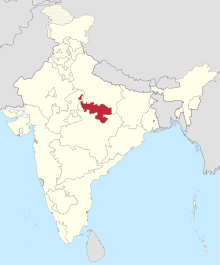
Madhya Bharat, also known as Malwa Union, was an Indian state in west-central India, created on 28 May 1948 from twenty-five princely states which until 1947 had been part of the Central India Agency, with Jiwajirao Scindia as its Rajpramukh.

Bagelkhand or Baghelkhand is a proposed state and a mountain range in central India that covers the northeastern regions of Madhya Pradesh and a small area of southeastern Uttar Pradesh.

Chhatarpur is a city and a municipality in Chhatarpur district in the state of Madhya Pradesh, India. It is the administrative headquarters of Chhatarpur District. Chhatarpur is a city and a municipality in Chhatarpur district in the state of Madhya Pradesh, India. It is the administrative headquarters of Chhatarpur District.

The Central India Agency was created in 1854, by amalgamating the Western Malwa Agency with other smaller political offices which formerly reported to the Governor-General of India. The agency was overseen by a political agent who maintained relations of the Government of India with the princely states and influence over them on behalf of the Governor-General. The headquarters of the agent were at Indore.
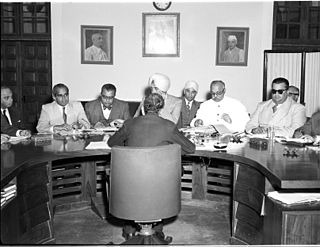
Rajpramukh was an administrative title in India which existed from India's independence in 1947 until 1956. Rajpramukhs were the appointed governors of certain Indian provinces and states.

Datia District is in Gwalior Division in the Indian state of Madhya Pradesh. The town of Datia is its district headquarters.

Rewa Division is an administrative geographical unit of Madhya Pradesh state of India situated in the northeast part of state bordering with Uttar Pradesh, Chhattisgarh and Baghelkhand region of Madhya Pradesh. Rewa is the administrative headquarters of the division. As of 2010, the division consists of districts of Rewa, Satna, Sidhi, Singrauli and Maihar districts. The division forms a part of the Baghelkhand region of Madhya Pradesh. The divisional headquarters in the Kothi Compound area of Rewa.
Satna is a city in the Indian state of Madhya Pradesh. It serves as the headquarters of Satna district. It is 7th largest city and 8th most populous city of the state. The city is 500 km east of the state capital Bhopal. The city is distributed over a land area of 111.9 square kilometres.

The Bundelkhand Agency was a political agency of the British Raj, managing the relations of the British government with the protected princely states of the Bundelkhand region.

The Bagelkhand Agency was a British political unit which managed the relations of the British with a number of autonomous princely states existing outside British India, namely Singrauli, Rewa and 11 minor states, of which the most prominent were Maihar, Nagod and Sohawal. Other principalities included Jaso, Kothi, Baraundha as well as the Kalinjar Chaubes, consisting of the princely estates of Paldeo, Kamta-Rajaula, Taraon, Pahra and Bhaisaunda.
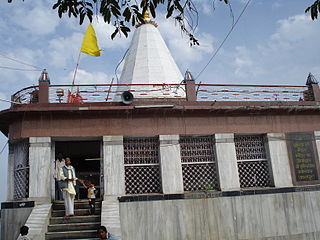
Satna District is a district of Madhya Pradesh state in central India. The city of Satna is the district headquarters. The district has an area of 7,502 km², and a population of 22,28,935(2011 census), 20.63% of which is urban. The district has a population density of 249 persons per km².
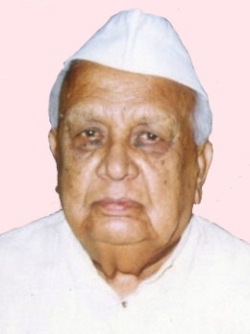
Shivanand was an Indian politician and a freedom fighter from Satna district of Madhya Pradesh. He was President of Rewa Rajya Praja Mandal from December 1946 to January 1948 and was jailed five times during freedom struggle and expelled from Rewa state many times. He was elected from Satna Constituency to the Vindhya Pradesh Legislative assembly in 1952 and sworn in as Speaker of that assembly. He was also member of Madhya pradesh Legislative assembly from 1957-62 along with Vishweshwar Prasad.
Sengar, also known as Sanghar, Singraur or Songar, are a clan of Rajputs in India.
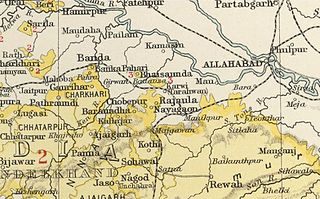
Paldeo, also spelt 'Paldev', was a princely estate (Jagir) in India during the British Raj. It was under the Bundelkhand Agency of the Central India Agency until 1896 when it was transferred to the Baghelkhand Agency. In 1931 it was transferred back to the Bundelkhand Agency. It had an area of 52 square miles. In 1940 its population was 9,820 distributed in 18 villages. Paldeo Estate was merged into the Indian state of Vindhya Pradesh in 1948.
Madhyanchal Gramin Bank is a regional rural bank in India. It is under the ownership of Ministry of Finance, Government of India. It was formed by merging three rural banks in the state of Madhya Pradesh in central India namely Madhya Bharat Bank, Sharda Grameen Bank, Rewa Sidhi Grameen Bank, sponsored by State Bank Of India, Allahabad Bank and Union Bank of India. Its headquarters is in Saugor. Current sponsor of the bank is State Bank of India. Madhyanchal Gramin Bank has presence over 13 districts in Madhya Pradesh Damoh, Sagar, Shivpuri, Guna, Ashoknagar, Tikamgarh, Chhatarpur, Panna, Satna, Rewa, Sidhi, Niwari and Singrauli. There are 454 branch and 7 regional offices in Rewa, Sidhi, Satna, Damoh, Shivpuri, Chhatarpur and Tikamgarh.

Panna State was a princely state of colonial India, located in modern Panna district of Madhya Pradesh.

Bhaisunda, also spelt 'Bhaisaunda', was a princely state in India during the British Raj.
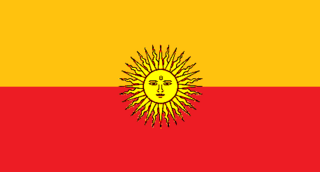
Tori Fatehpur, also known as Tori, was a princely state in India during the British Raj. It was one of the Hasht-Bhaiya Jagirs, under the Bundelkhand Agency of British India. Today it is part of Jhansi District in the state of Uttar Pradesh.

Pahra was a jagir in India during the British Raj. It was under the Bundelkhand Agency of the Central India Agency until 1896 when it was transferred to the Baghelkhand Agency. It was later transferred back to the Bundelkhand Agency.
The Benvanshi or Venvanshi is a Rajput clan found in India. It is part of the Rajput Chandravanshi dynasty. Families belonging to this clan ruled several kingdoms and feudal zamindaries (estates). The Venvanshi people are the predominant people in southern parts of Uttar Pradesh like Mirzapur, Sonbhadra, parts of Madhya Pradesh like the Baghelkhand region and northern parts of Chhattisgarh and western parts of Bihar.
